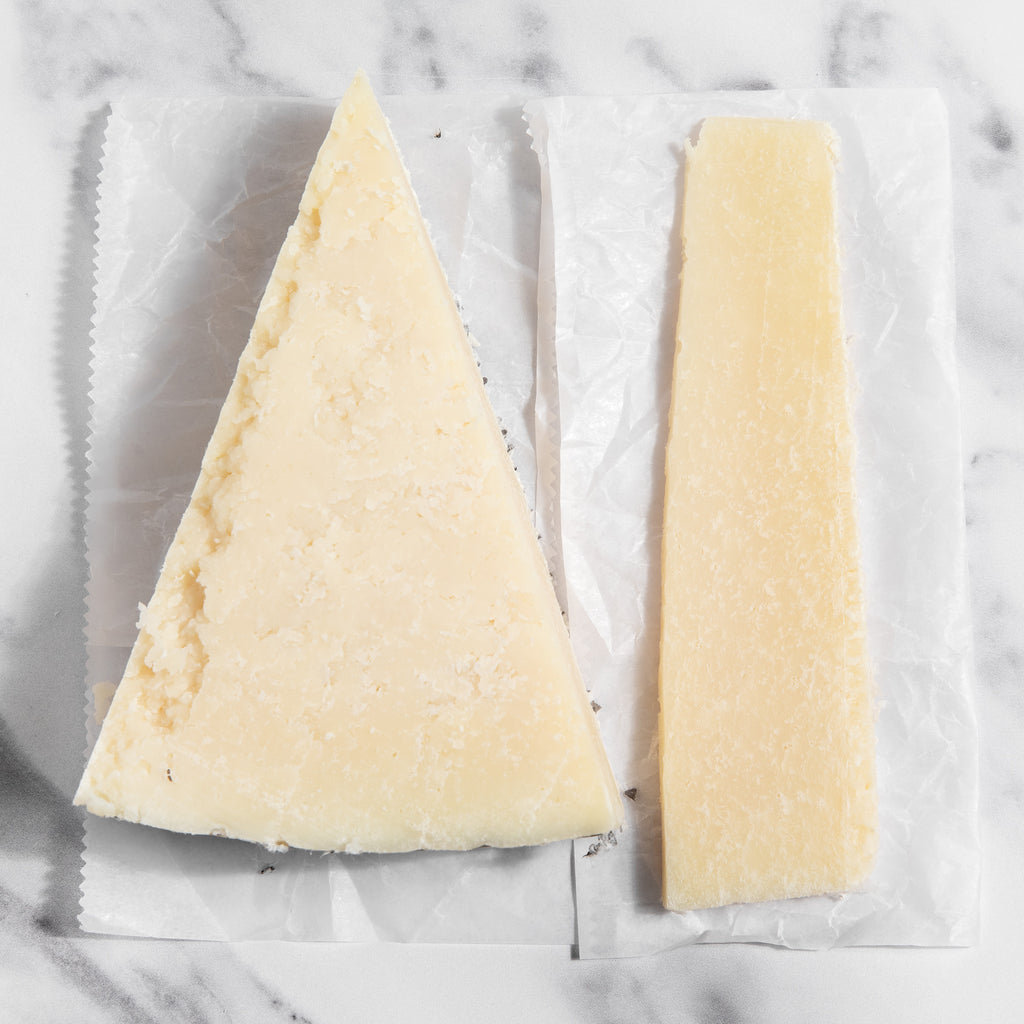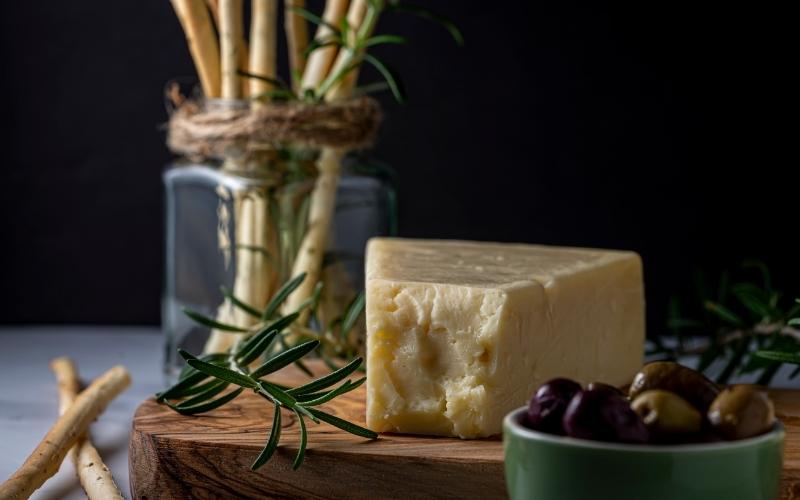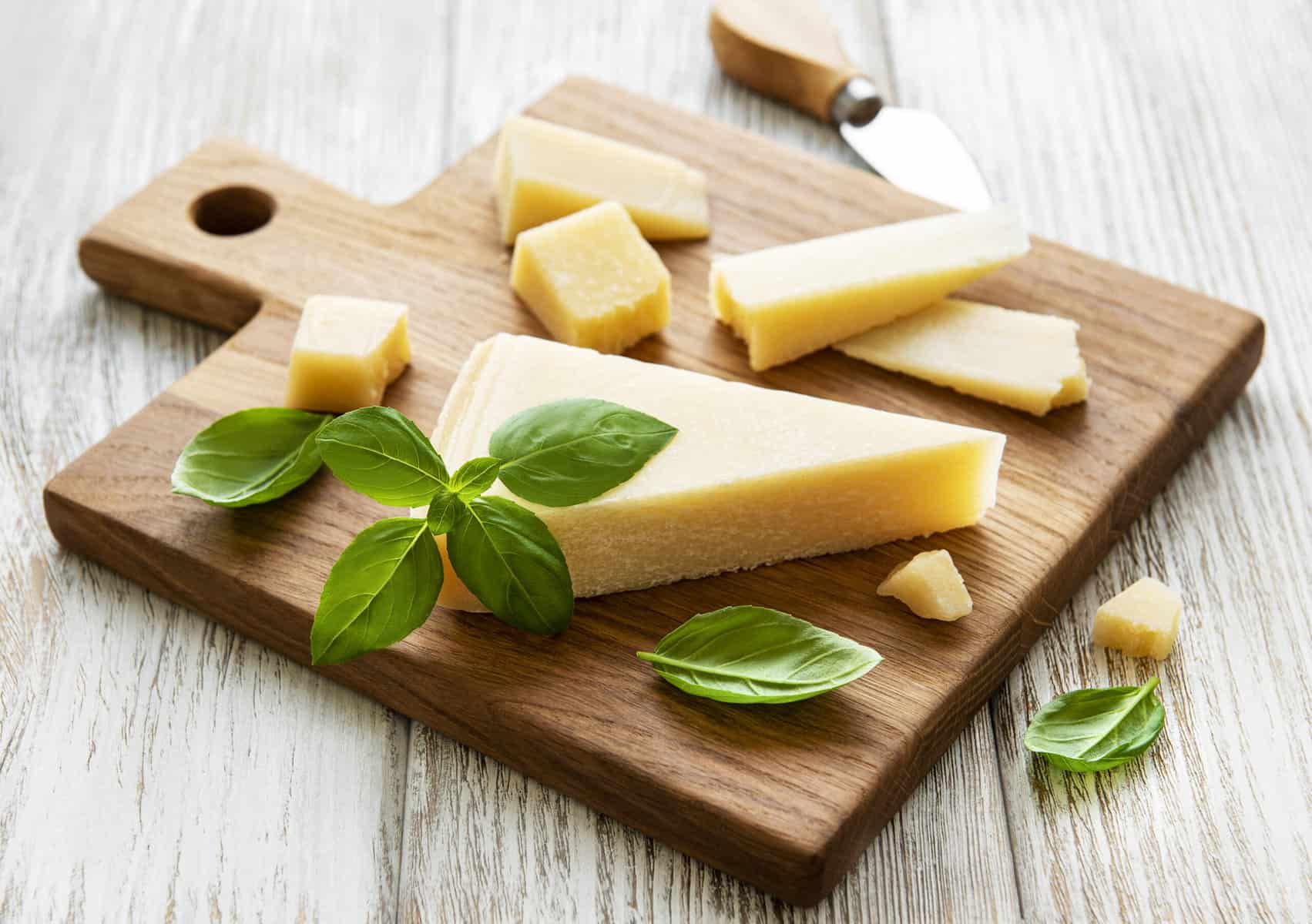Introduction

Italian cuisine is well-known for its wide variety of delicious cheeses, and two popular options are Asiago and Parmesan. While they may look similar, these cheeses have distinct characteristics and flavors that make them stand apart. In this showdown between Asiago cheese and Parmesan, we will explore their history, aging processes, taste profiles, and culinary uses. Additionally, we will compare their nutritional values and discuss some delectable recipes that showcase the uniqueness of these Italian cheeses. Whether you prefer the creamy, nutty notes of Asiago or the sharp, robust flavors of Parmesan, this article will help you make an informed decision.
Overview Of Asiago Cheese And Parmesan
Asiago cheese and Parmesan are both beloved Italian cheeses that have their distinct characteristics and flavors. Asiago cheese is known for its buttery, creamy, and nutty notes, with a slightly more noticeable bitterness in the aged varieties. On the other hand, Parmesan is renowned for its sharpness, robustness, and distinct earthiness, as well as well-expressed fruity and savory notes. While Asiago leans towards a creamy and nutty profile, Parmesan offers a more intense flavor experience. Both cheeses are highly versatile and widely used in various culinary applications, adding depth and richness to dishes.
History And Cultural Significance Of Both Cheeses
Both Asiago cheese and Parmesan have a rich history and cultural significance in Italy. Asiago cheese can be traced back to the Alpine region of Veneto, where it was first made by local farmers in the Middle Ages. It became popular as a staple food for shepherds and gained recognition as a protected designation of origin (PDO) cheese in 1978. On the other hand, Parmesan cheese, also known as Parmigiano-Reggiano, has been produced for over 900 years in the Emilia-Romagna region. It holds a prestigious reputation as one of Italy’s most famous and traditional cheeses, known worldwide for its quality and flavor. Both cheeses are deeply embedded in Italian culture and are celebrated as culinary treasures.
Asiago Cheese

Asiago cheese is a renowned Italian cheese that originates from the Alpine region of Veneto, Italy. It is known for its distinctive flavors and textures. Made from cow’s milk, Asiago cheese is aged to develop its unique characteristics. There are two main types of Asiago cheese: fresh Asiago, which is smooth and mild, and Asiago d’allevo, which is aged and has a stronger, nuttier flavor. This versatile cheese is commonly used in various dishes, including salads, pastas, and sandwiches. Its distinct flavor adds depth and richness to any culinary creation.
Types And Aging Process Of Asiago Cheese
Asiago cheese is available in two main types: fresh Asiago and Asiago d’allevo. Fresh Asiago is typically aged for a shorter period of time, resulting in a smooth and mild flavor. It has a pale yellow color and a soft texture. On the other hand, Asiago d’allevo is aged for a longer time, allowing it to develop a stronger and nuttier flavor. It has a darker yellow color and a firmer texture. The aging process of Asiago cheese contributes to its unique taste and texture, making it a versatile choice for various culinary applications.
Flavor Profile And Culinary Uses Of Asiago Cheese
Asiago cheese offers a distinctive flavor profile that combines elements of nuttiness and creaminess. It has a buttery texture with a slight tang and a hint of bitterness, especially in aged varieties like Asiago Stravecchio. This adds depth and complexity to dishes. In terms of culinary uses, Asiago cheese is incredibly versatile. It can be enjoyed as a standalone cheese or grated over pasta, pizza, and salads to add a rich and savory taste. It also pairs well with fruits, cured meats, and crackers, making it a great addition to cheese boards and appetizers.
Parmesan Cheese

Parmesan cheese, also known as Parmigiano Reggiano, is a renowned Italian cheese with a rich history and cultural significance. It is a hard, granular cheese that is aged for a minimum of 12 months, but can be aged up to 36 months or more. Parmesan cheese has a sharp and robust flavor, with hints of fruitiness and savory notes. It also exhibits a distinct earthiness, adding depth to dishes. It is commonly grated and sprinkled over pasta, risottos, soups, and salads to enhance their flavors. Parmesan cheese is a versatile ingredient that adds a touch of sophistication to any dish.
Varieties And Aging Techniques Of Parmesan
Parmesan cheese, also known as Parmigiano Reggiano, comes in a variety of aging options. The traditional Parmigiano Reggiano is aged for a minimum of 12 months, but there are also longer-aged versions available. The Riserva variety is aged for at least 24 months, resulting in a richer and more intense flavor. For those seeking an even stronger taste, the Extra Vecchio Parmigiano Reggiano is aged for a minimum of 36 months. The aging process involves careful monitoring and control of temperature and humidity, allowing the cheese to develop its characteristic flavors and textures. This attention to detail ensures that each piece of Parmesan cheese is of the highest quality.
Taste Characteristics And Culinary Applications Of Parmesan
Parmesan cheese is known for its rich and bold flavor. It has a nutty and slightly sweet taste with hints of fruitiness and savory notes. The texture of Parmesan is granular and crumbly, which adds a pleasant mouthfeel to dishes. Parmesan is incredibly versatile in the kitchen and can be used in a variety of ways. It is commonly grated over pasta, risottos, and salads, adding a savory depth and enhancing the overall flavor. Parmesan can also be melted into creamy sauces, baked into crispy crusts, or simply enjoyed on its own as a flavorful snack. Its versatility makes Parmesan a staple ingredient in Italian cuisine and a favorite among cheese lovers worldwide.
Asiago Vs Parmesan: Nutritional Comparison

When it comes to nutritional content, both Asiago and Parmesan cheeses have their unique advantages. Asiago cheese is lower in calories, fat, and cholesterol compared to Parmesan. However, Parmesan cheese is higher in protein, calcium, and phosphorus, making it a great choice for those looking to increase their intake of these nutrients. Additionally, Parmesan has a slightly lower sodium content compared to Asiago. Both cheeses provide essential vitamins and minerals, but it’s important to consider your nutritional needs and preferences when deciding between Asiago and Parmesan.
Nutritional Content And Health Benefits Of Asiago Cheese
Asiago cheese is not only delicious but also offers a range of nutritional benefits. It is lower in calories, fat, and cholesterol compared to Parmesan, making it a healthier option for those watching their calorie intake. Asiago cheese is also a good source of protein, calcium, and phosphorus, which are essential for maintaining strong bones and teeth. Additionally, it provides vitamins A and B12, which play a crucial role in supporting immune function and energy production. With its rich flavor and nutritional profile, Asiago cheese is a versatile and nutritious addition to any diet.
Nutritional Value And Advantages Of Parmesan Cheese
Parmesan cheese, known for its rich flavor, also offers various nutritional benefits. It is a good source of protein and contains essential amino acids that support muscle growth and repair. Additionally, Parmesan is high in calcium, promoting strong bones and teeth. It also provides significant amounts of vitamins A and B12, which contribute to healthy vision, immune function, and energy production. With its low lactose content, Parmesan can be enjoyed by those with lactose intolerance. Including Parmesan cheese in your diet can provide a tasty way to meet your nutritional needs.
Cooking With Asiago And Parmesan

Both Asiago and Parmesan cheeses can elevate the flavors of various dishes and are commonly used in cooking. Asiago cheese pairs well with roasted vegetables, pasta dishes, and soups, adding a creamy and nutty taste. It can be grated or melted to enhance the flavors of these recipes. Parmesan cheese is a versatile ingredient that can be grated over pasta, salads, and roasted vegetables for a rich and savory taste. It is also commonly used as a key ingredient in Italian dishes such as risotto and pesto. Whether you’re making a classic Italian dish or experimenting with new recipes, both Asiago and Parmesan cheeses can bring depth and richness to your cooking.
Recipes Featuring Asiago Cheese
Asiago cheese is a versatile ingredient that can be used in a variety of recipes to add a creamy and nutty flavor. One popular recipe is Asiago cheese pasta, where grated Asiago cheese is added to cooked pasta along with sautéed vegetables and herbs. Another delicious option is Asiago-stuffed chicken breasts, where a mixture of Asiago cheese, breadcrumbs, and herbs is stuffed inside chicken breasts and baked until golden and melted. For a vegetarian option, consider making Asiago cheese and roasted vegetable tart, where a flaky pastry crust is filled with a mixture of roasted vegetables and Asiago cheese. These recipes showcase the delightful taste of Asiago cheese and can be enjoyed by cheese lovers everywhere.
Dishes Enhanced With Parmesan Cheese
Parmesan cheese is a versatile ingredient that can elevate the flavors of various dishes. Its savory and nutty profile makes it a perfect addition to pasta dishes, such as spaghetti carbonara or fettuccine alfredo. Parmesan can also be grated over roasted vegetables like asparagus or Brussels sprouts to add a rich and savory element. For a lighter option, sprinkle Parmesan on top of a Caesar salad or a bowl of creamy tomato soup. Additionally, Parmesan can enhance the flavors of risottos, meatballs, and even pizza. The possibilities are endless when it comes to incorporating Parmesan cheese into your culinary creations.
Conclusion

In conclusion, the comparison between Asiago cheese and Parmesan cheese highlights the unique qualities and flavors of each variety. Asiago cheese offers a buttery and nutty profile with a noticeable bitterness, while Parmesan cheese brings a sharp and robust taste with fruity and savory notes. Both cheeses have their own distinct characteristics that can elevate a variety of dishes. Whether you choose Asiago or Parmesan, incorporating these delicious Italian cheeses into your cooking will undoubtedly enhance your culinary creations. So, explore the flavors of both cheeses and enjoy the wonderful world of Italian cuisine.
Final Thoughts On Asiago Vs Parmesan
In conclusion, the comparison between Asiago cheese and Parmesan cheese highlights the unique qualities and flavors of each variety. Asiago cheese offers a buttery and nutty profile with a noticeable bitterness, while Parmesan cheese brings a sharp and robust taste with fruity and savory notes. Both cheeses have their own distinct characteristics that can elevate a variety of dishes. Whether you choose Asiago or Parmesan, incorporating these delicious Italian cheeses into your cooking will undoubtedly enhance your culinary creations. So, explore the flavors of both cheeses and enjoy the wonderful world of Italian cuisine.
Recommendations For Pairing And Enjoying Both Cheeses
When it comes to pairing and savoring Asiago and Parmesan cheeses, there are plenty of delicious options to explore.
For Asiago, its buttery and nutty flavor works wonderfully with grilled vegetables, pasta dishes, and roasted meats. Try crumbling Asiago over a fresh salad or pairing it with sliced pears and walnuts for a delightful appetizer.
Parmesan, with its sharp and robust taste, is perfect for enhancing pasta dishes, risottos, and soups. Shave Parmesan over a bowl of spaghetti or sprinkle it on top of a hearty minestrone for an extra burst of flavor.
Both cheeses also pair well with wines such as Chianti or Pinot Grigio, enhancing the overall culinary experience. So, whether you choose Asiago or Parmesan, enjoy the delightful flavors and versatility these Italian cheeses bring to your meals.
FAQ About “asiago Cheese Vs Parmesan: Italian Cheese Showdown”
Q: What is the main difference between Asiago and Parmesan cheese?
A: The main difference lies in the type of milk used and the aging process. Asiago cheese is traditionally made from cow’s milk in the Asiago region of Italy and has a sweeter, milder flavor. Parmesan, on the other hand, is made from unpasteurized cow’s milk in the Parma region and has a nuttier, sharper taste due to its longer aging period.
Q: Can Asiago and Parmesan cheese be used interchangeably in recipes?
A: While both cheeses are versatile and can be grated over pasta or salads, they do have distinct flavors. Parmesan is commonly used for its intense umami taste, while Asiago adds a creamy, buttery note to dishes. It is best to use each cheese according to its unique flavor profile in recipes.
Q: Are Asiago and Parmesan cheeses lactose-free?
A: Both Asiago and Parmesan cheeses are low in lactose due to the fermentation process during cheese-making. Individuals who are lactose intolerant may still be able to enjoy these cheeses in moderation.
Q: How should Asiago and Parmesan cheeses be stored to maintain freshness?
A: It is best to store both cheeses in the refrigerator, tightly wrapped in wax paper or plastic wrap to prevent them from drying out. Avoid storing them in airtight containers as they need to breathe. Grated Parmesan can also be stored in the freezer for longer shelf life.
Q: What are some popular dishes that feature Asiago or Parmesan cheese?
A: Asiago cheese is commonly used in dishes such as risotto, salads, and sandwiches, while Parmesan cheese is a staple in pasta dishes like spaghetti carbonara, Caesar salad, and risotto. Both cheeses are also popular choices for cheese boards and pair well with fruits, nuts, and wine.
Q: Are Asiago and Parmesan cheeses suitable for individuals with gluten intolerance?
A: Asiago and Parmesan cheeses are naturally gluten-free as they are made from milk, enzymes, and salt. They are safe to consume for individuals with gluten intolerance or celiac disease as long as there are no added ingredients that contain gluten.

Salsas by Karoll’s Catering is a vibrant and innovative Canadian fusion family restaurant that welcomes you to indulge in a delightful culinary experience. Every Sunday, from 11 am to 2 pm, we invite you for a delicious brunch that will tantalize your taste buds. Whether you prefer dining in or taking out, we ensure that our delectable dishes are available to savour at your convenience. In addition to our enticing Sunday brunch, we host a lively happy hour every Thursday, Friday, and Saturday. During this time, you can enjoy discounted food items, get $2.50 off on beer, and sip on refreshing $5 margaritas. It’s the perfect opportunity to unwind and relish in the flavours of our Canadian fusion cuisine.